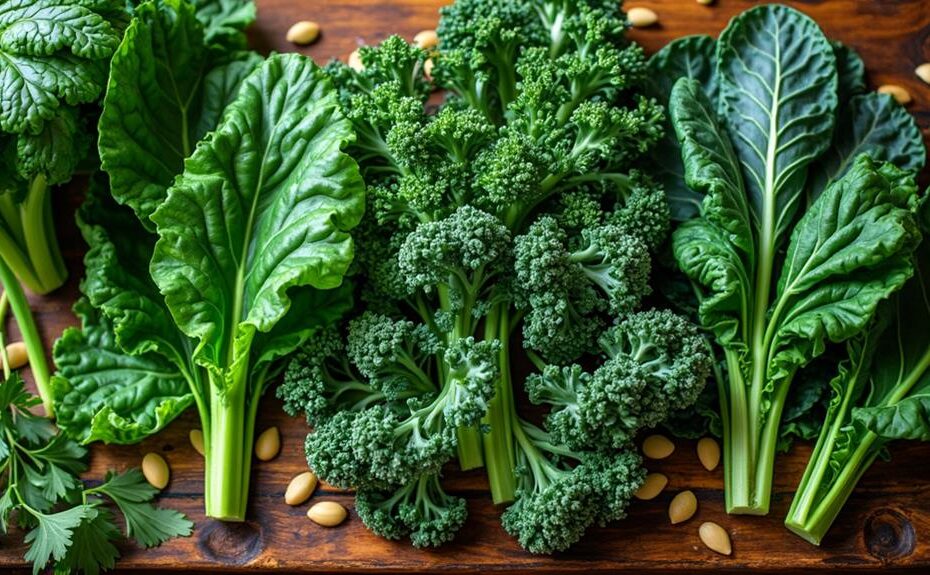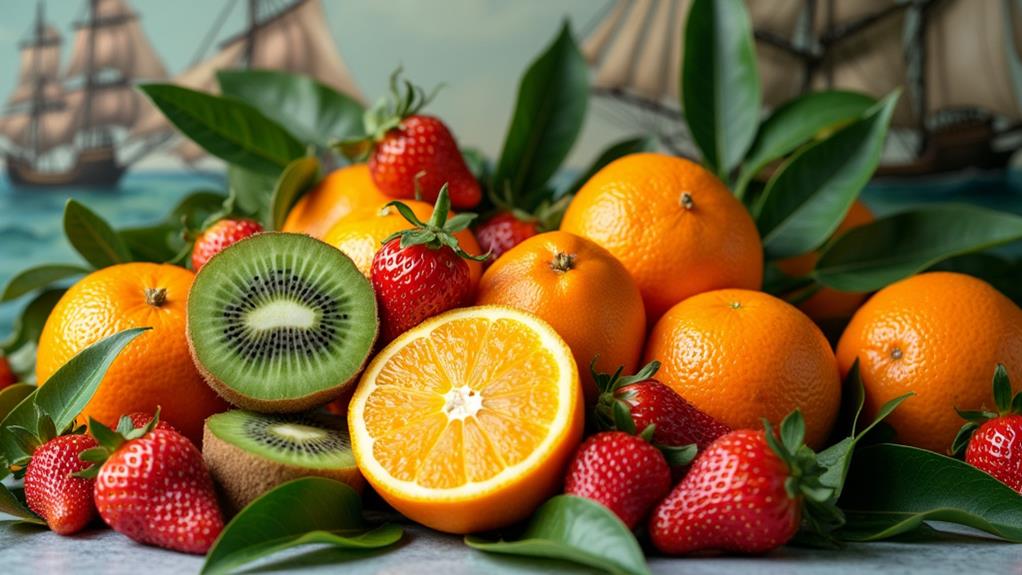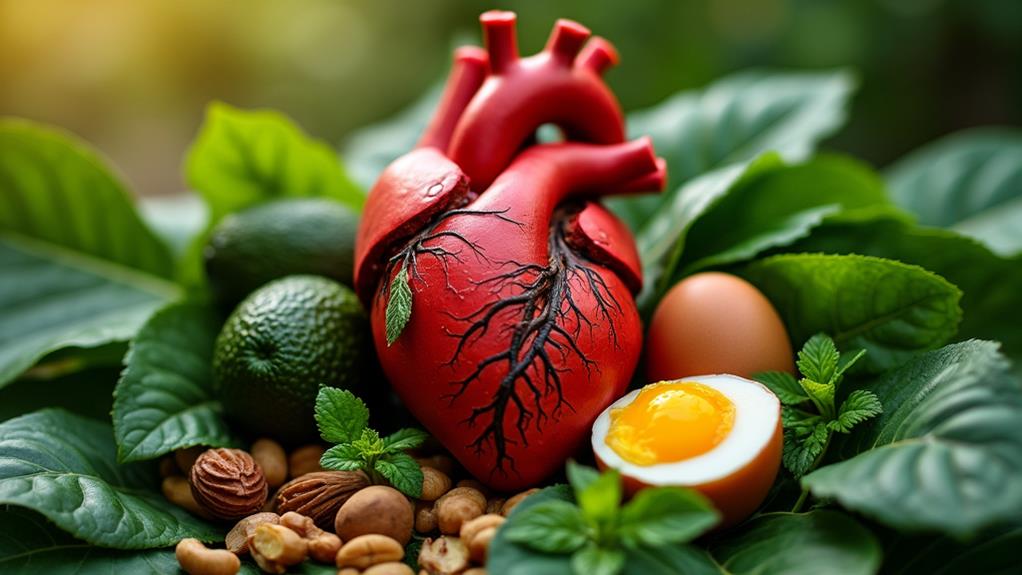







You can find dietary sources of vitamin K1 in leafy greens, fruits, legumes, and vegetable oils. Dark leafy greens like kale, collard greens, and spinach are particularly rich, providing over 100% of the daily value when cooked. Avocado, kiwi, and blueberries also contribute to your intake. Legumes, like green peas and chickpeas, offer smaller amounts. Don't forget about soybean and canola oils, which can add vitamin K1 to your diet. Incorporating healthy fats when you prepare these foods can help with absorption. There's more to explore about enhancing your vitamin K1 intake effectively.
Key Takeaways
- Leafy greens like kale, collard greens, and spinach are among the richest sources of vitamin K1.
- Fruits such as avocados, kiwis, and blueberries provide moderate amounts of vitamin K1.
- Legumes and nuts, including green peas and chickpeas, contribute smaller quantities of vitamin K1.
- Vegetable oils, particularly soybean and canola oil, add vitamin K1 when used in cooking and dressings.
- Herbs like basil, thyme, and oregano also contain beneficial levels of vitamin K1 for flavor and nutrition.
Importance of Vitamin K1
Why is vitamin K1 essential for your health? This significant nutrient, also known as phylloquinone, plays an important role in blood clotting. Without adequate vitamin K1, your body can't produce the proteins necessary to prevent excessive bleeding. It's primarily found in leafy greens like kale, spinach, and collard greens, making these vegetables excellent sources. For instance, just half a cup of cooked kale provides an impressive 443% of the Daily Value. Additionally, vitamin K1 is crucial for bone strength and helps regulate calcium levels in the body, which is essential for maintaining overall bone health and density promotes strong bones.
Moreover, vitamin K1 is important for bone health. It contributes to the mineralization of bones, potentially lowering your risk of osteoporosis. A diet rich in this vitamin promotes strong bones by ensuring that calcium is effectively utilized in the skeletal system. To maximize absorption, pair your leafy greens with dietary fats, such as olive oil or avocado. This combination enhances the bioavailability of vitamin K1, allowing your body to absorb it more efficiently.
Incorporating a variety of vitamin K1-rich foods into your dietary intake not only supports your blood clotting mechanisms but also fortifies your bone structure, ultimately contributing to your overall health.
Top Food Sources of Vitamin K1
A well-rounded diet rich in vitamin K1 can greatly enhance your health, particularly through the foods you choose. Leafy greens are some of the top dietary sources of this essential nutrient. For instance, cooked kale stands out as one of the richest sources, providing an impressive 443% of the Daily Value (DV) in just half a cup. Vitamin K1 is necessary for blood clotting and maintaining healthy coagulation levels, making it especially important for individuals on certain medications, as noted in how it interacts with blood thinners. Spinach also offers a significant amount of vitamin K1, delivering around 181% of the DV in a similarly sized cooked portion.
Collard greens take the lead with a remarkable contribution of around 530 mcg, translating to 442% of the DV in half a cup cooked. Additionally, broccoli is a valuable source, supplying approximately 110 mcg or 92% of the DV in half a cup cooked. To maximize the absorption of vitamin K1 from these leafy greens, consider incorporating healthy fats into your meals. Ingredients like olive oil or avocado can enhance your body's ability to absorb this important nutrient. By including these top food sources in your diet, you can make sure you're getting adequate vitamin K1 for ideal health.
Vegetables Rich in Vitamin K1
Vegetables are a powerhouse of nutrition, and when it comes to vitamin K1, dark leafy greens reign supreme. Incorporating these vegetables rich in vitamin K1 into your diet is essential for supporting healthy blood clotting and bone health, as noted in various studies. Cooked kale stands out, providing an impressive 443% of the Daily Value (DV) in just 1/2 cup. Spinach is another excellent choice; it offers about 72.5 mcg of vitamin K1 per 3 oz when raw, making it a versatile addition to salads and smoothies.
Collard greens are also significant, delivering around 530 mcg of vitamin K1 per 1/2 cup when cooked. This makes them one of the top dietary sources of this vital nutrient. Swiss chard packs a punch as well, contributing about 480 mcg of vitamin K1 per 1/2 cup when cooked. Finally, don't overlook broccoli, which provides about 110 mcg of vitamin K1 per 1/2 cup when cooked. By including these nutrient-dense leafy greens in your meals, you can effectively enhance your vitamin K1 intake and support your overall health. For those considering supplementation, Solaray's Vitamin K-1 is a reputable option to explore.
Fruits Containing Vitamin K1
While vegetables dominate the vitamin K1 landscape, certain fruits can still play a role in boosting your intake of this essential nutrient. Avocado, for instance, provides a modest amount of vitamin K1, containing approximately 21 mcg per 100 grams. This makes it a tasty option to incorporate into your diet for enhancing your overall nutrient intake.
Kiwi stands out as another beneficial fruit, offering around 40 mcg of vitamin K1 per 100 grams. Including kiwi in your meals can help you approach your daily vitamin K1 needs. Blueberries and grapes, while lower in vitamin K1, still contribute to your overall intake, with blueberries providing about 19 mcg and grapes around 14 mcg per 100 grams.
Figs also offer a small amount of vitamin K1, containing about 3 mcg per 100 grams. Though these fruit sources contain less vitamin K1 compared to leafy greens, they can still support your health when combined with other dietary sources. By diversifying your intake and including these fruits, you can enjoy a delicious way to enhance your vitamin K1 levels.
Legumes and Nuts With Vitamin K1
How can legumes and nuts contribute to your vitamin K1 intake? While they aren't the richest sources, incorporating these foods into your diet can still enhance your overall vitamin K1 levels. For instance, a half-cup of cooked green peas provides approximately 24 mcg of vitamin K1, making them a valuable addition to your meals. Chickpeas offer smaller amounts, yielding about 6 mcg per half-cup when cooked, while lentils supply roughly 2.5 mcg for the same serving size.
When it comes to nuts, pine nuts and walnuts also contribute trace amounts of vitamin K1, with pine nuts containing around 2.7 mcg per quarter-cup. Although these figures may seem modest, every bit counts toward achieving a balanced diet rich in dietary sources of essential nutrients.
Including a variety of legumes and nuts in your meals not only helps you meet your vitamin K1 needs but also provides other health benefits like protein, fiber, and healthy fats. So, consider adding green peas, chickpeas, lentils, and nuts to your daily routine for a nutritious boost.
Cooking Techniques for Vitamin K1
Maximizing your vitamin K1 intake involves not just choosing the right foods but also employing effective cooking techniques. Cooking leafy greens like kale and spinach can enhance the availability of vitamin K1 by breaking down cell walls, making it easier for your body to absorb this essential nutrient. Among the various cooking techniques, steaming stands out as a preferred method. It retains more vitamin K1 compared to boiling, which can lead to considerable nutrient loss.
Incorporating healthy fats—such as olive oil or avocado—when preparing vitamin K1-rich dishes can greatly improve absorption, given that vitamin K1 is fat-soluble. For those who enjoy raw consumption, salads with high-vitamin K1 greens like Swiss chard and collard greens maximize the amount of this nutrient available in your diet.
Lightly sautéing or stir-frying vegetables with a small amount of oil also strikes a good balance between flavor and nutrient retention. These techniques not only enhance the taste of your dishes but also guarantee you're getting the most out of your vitamin K1-rich foods. By using these cooking methods, you'll optimize your intake and support your overall health.
Tips to Increase Vitamin K1 Intake
To boost your vitamin K1 intake effectively, start incorporating dark leafy greens into your daily meals. For instance, adding just half a cup of cooked kale provides an impressive 443% of the Daily Value (DV) for vitamin K1. Spinach and collard greens are also excellent choices. Don't forget other vegetables like broccoli and Brussels sprouts—half a cup of cooked broccoli offers about 110 mcg of vitamin K1.
Using vegetable oils, such as soybean or canola oil, can further enhance your intake. A tablespoon of these oils adds approximately 25 mcg of vitamin K1, making them perfect for salad dressings or cooking. You can also elevate your dishes by adding herbs and spices like basil, thyme, and oregano, which contribute notable levels of vitamin K1.
Conclusion
Incorporating vitamin K1 into your diet is like adding a vibrant green hue to your health canvas. From leafy greens to crunchy nuts, these foods not only enhance your meals but also fortify your body. By embracing a variety of sources, you're ensuring your bones stay strong and your blood remains healthy. So, don't shy away from salads or stir-fries; let your plate reflect the richness of vitamin K1, and watch your wellness flourish!






